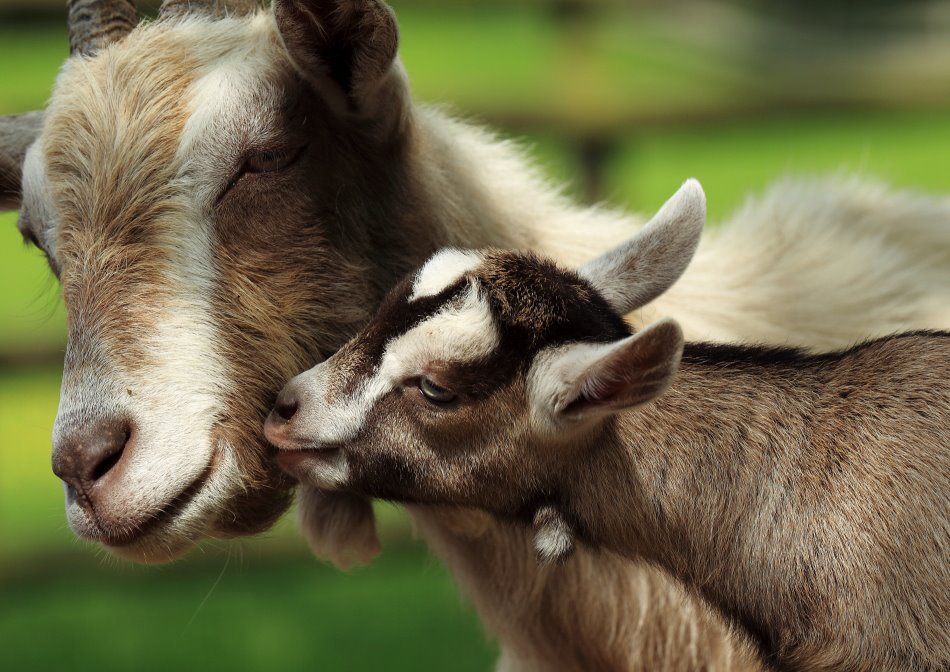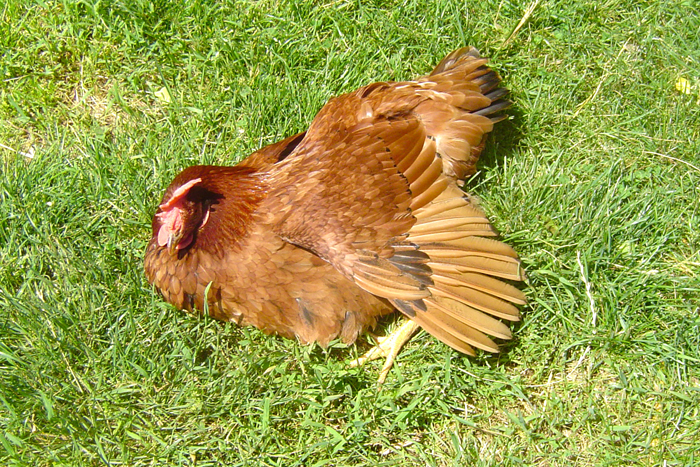
Yes, Animals Have Feelings (Op-Ed)

Jonathan Balcombe is director of animal sentience at the Humane Society Institute for Science and Policy. He contributed this article to Live Science's Expert Voices: Op-Ed & Insights.
On Saturday mornings I drive 15 miles to a sanctuary in rural Maryland where I join a small team of volunteers tending to farm animals rescued from neglect or abuse. Some of these animals will never fully trust a human. Others want to interact.
As a biologist with a special interest in animal happiness, I've figured out where they like to be scratched and rubbed. Goats, such as Trudy or Malcolm, walk over to me and lean gently against my leg. I scratch between their horns, caress their faces and vigorously swipe my hand down their backs and flanks. They become noticeably more relaxed. Their eyelids droop and they stand completely still. One of the older sheep, a ram named Adam, wags his tail in approval when he is petted. Another sheep, Clover, once scraped her hoof across my boot repeatedly when I briefly stopped massaging her back — a sheep's way of asking for more. At the pig barn, 700-pound adults lying blissfully on soft hay will assist the effort to give them a belly-rub by shimmying further onto their sides and raising their legs. And when the chicken barn door opens, about 20 birds come surging out into the sunlit garden. They spend the next few hours foraging. They nibble at seeds and vegetation, and search for invertebrates by pawing backwards at the earth with their strong feet then stooping down to peer and peck at any moving morsel they've uncovered. They do this with devotion, taking breaks to sunbathe by reclining on their sides, fluffing out their feathers, and stretching a wing to maximize the surface area available to the sun's warm rays.
Animals and sentience
Watching these animals pursue their wants and needs reminds me that they are individuals with intentions and preferences. Their lives matter to them. Their desire for rewards is part of sentience — the capacity to feel. Sentience encompasses a universe of positive and negative physical and emotional experiences.
Today, most scientists agree that all vertebrate animals — mammals, birds, reptiles, amphibians and fish — are, to varying degrees, sentient. A rich and varied collection of research has made the evidence impossible to dismiss.
But this perspective wasn't always popular.
Sign up for the Live Science daily newsletter now
Get the world’s most fascinating discoveries delivered straight to your inbox.
Historically, for example, sea-life rarely made it into humanity's realm of concern when it came to the ability to suffer. But meticulous experiments performed on trout a decade ago essentially have laid to rest the common view that a fish cannot feel pain. There now is also scientific support for sentience in at least some invertebrates. In research by Canadian biologist Jennifer Mather and colleagues, octopuses show curiosity, play and personality. And in a study led by Robert Elwood at Queens University Belfast, prawns spent more time grooming and rubbing a pinched antenna, unless they received a follow-up application of local anesthetic.
Once deemed inscrutable, animal emotions are now also considered a legitimate source of inquiry. Although humans cannot know for certain what an animal is feeling (indeed, we cannot know for certain what another human is feeling), we can observe changes in behavior and physiology and infer emotions. The evidence is even more compelling when we find that these changes echo changes in our bodies when we are exposed to similar stimuli.

What dogs are teaching about animal cognition
Because they are so expressive and responsive to us, domestic dogs have lately become the darlings of research on animal cognition and emotion.
During a recent visit to the Clever Dog Lab at the University of Vienna, I watched a dog select symbols on a computer screen by touching it with his nose. In another room, dogs placed their heads on a chin-rest to watch images projected on a computer screen. These are not purpose-bred "lab dogs," but happy pets recruited for the studies. The chin-rest apparatus has been used to show that dogs, like us, glance first to the left side of a human face, where our bilateral brains display more emotion. Thus, dogs get a quick read of our moods and intentions. This all happens in a fraction of a second, and like us, dogs probably are unaware they are doing it. Neither they nor we regard a dog's face this way, which makes sense because dogs' emotions are expressed uniformly on their faces. The wag of a dog's tail also contains subtle cues to their moods. Led by Giorgio Vallortigara of the University of Trento, Italian researchers found that dogs remained relaxed when they saw films of dogs whose tails were wagging predominantly to the right, but they became anxious if the tail wagged more to the left. [Dog Kisses are More Than Just Slobber (Op-Ed )]
At Emory University, scientists are using positive reinforcement to train pet dogs to remain motionless inside an fMRI machine, allowing scientists to monitor brain activity while the dogs react to visual stimuli. Preliminary studies show brain reward centers light up when dogs see a hand signal that is normally followed by something good (a food treat), but not for a neutral hand signal. Similarly, when presented with five scents (self, familiar human, strange human, familiar dog, strange dog), dogs' brains registered the strongest delight in response to the familiar human. It appears the notion that the dog is "man's best friend" cuts both ways.
Animals and complex emotion
It is well established that when people feel depressed, we are more likely to take a pessimistic view of life. It seems we are not alone in that tendency. In a study led by Melissa Bateson of England's Newcastle University , European starlings were housed for ten days in either socially enriched enclosures with branches and water baths, or alone in smaller, barren cages.
Both sets of birds learned to forage by plucking lids from dishes, each containing a worm. The birds soon learned that dishes with white lids contained tasty worms, whereas dishes with dark gray lids harbored unpalatable (quinine-flavored) worms. Birds from both groups soon stopped flipping the dark gray lids. But when the experimenters began presenting the starlings with ambiguous dishes — lidded with lighter shades of gray — they found that "enriched" birds were more likely than emotionally impoverished birds to flip these new lids and sample the worm inside. Moreover, enriched birds became markedly pessimistic — shunning the ambiguous lids — if they were switched from enriched to impoverished lodgings. The researchers concluded that enriched starlings are more optimistic than impoverished, and presumably less happy, ones.
In a range of studies, rats, pigs, goats, and intriguingly, honey-bees all have shown the same optimism/pessimism response (scientists call it "cognitive bias") to uncertain outcomes. It seems that life for an animal can go well or ill, and that an individual's inner state has an ambient dimension beyond the fleeting emotions of a given moment.
Perhaps more predictably, baboons also have lasting emotional states. Following the death of an infant, baboon mothers show physiological and behavioral responses that mirror those of bereft women. Glucocorticoid hormones — associated with grief in humans — rise and take a month to subside again, and the bereaved mother monkey seeks therapy by expanding her social network through increased grooming interactions with other baboons.
Body temperature provides yet another window into feelings. Human body temperatures rise when we are nervous or anxious about an approaching event, such as an exam or a competition. A rat, handled by an unfamiliar person, gets warmer by 1° Celsius or more. If the same person returns to handle the rat over successive days, the rat's thermal response declines, and by about day five, her body temperature stops rising altogether. If, however, a new handler shows up on the sixth day, the rat's body temperature rises again, indicating that her temperature changes are psychologically based. This so-called emotional fever has also been documented in turtles and lizards. So much for "cold-blooded" reptiles.
The bonds between fish
Scientists have not yet shown emotional fever in fish, although I'm aware of only one study that has explored this. Does this mean that fish cannot feel emotions? Not likely. Emotions are very useful , and fish are highly evolved. They behave emotionally, showing fear, excitement, anger, pleasure and anxiety. Their brains produce the same compounds that accompany emotions in mammals. It takes 48 hours for fish hormone levels to return to normal after rough handling, such as being caught by anglers and put into small buckets.
On coral reefs, the interactions between cleaner-fish and their clients are rich with awareness and emotion. Cleaners flaunt their bright colors to advertise that they are open for business. Client fish of varied species queue up for their turn for an inspection from the cleaners, who work individually or in pairs, plucking off parasites, algae and other undesirables. Both parties benefit: the cleaners get food, and the clients get a spa treatment. This is not a willy-nilly arrangement. Clients have their favorite cleaners to whom they return repeatedly. Other client fish observe those interactions, keeping accounts of who cleans well and who does a shoddy job. There are good reasons for this so-called "image-scoring" behavior: Some cleaners may nip at the precious mucus that forms a protective shield over the client's scales. This causes the client fish to jolt, and to sometimes angrily chase the cleaner. Other "cleaners" are scheming impostors, sharp-toothed mimics that look almost identical to cleaners, then nip off a chunk of fin and flee to safety. [If Sharks Feel Pain, Why Are They Not Better Protected? (Op-Ed )]
Careful studies by Swiss researchers led by Redouan Bshary have documented that cleaners cause fewer jolts when potential clients are watching. The cleaners also pamper their patrons by gently caressing them with their fins. Just as touch is therapeutic for humans, so too with fish. In a study from the Marta Soares and colleagues at the University of Lisbon, captive surgeonfish had lower levels of stress hormone when they could sidle up to a mechanical wand that delivered gentle strokes.

Which brings me to Larry. He's a Bahamian grouper befriended by Florida-based journalist and author Cathy Unruh. When Unruh scuba-dives in Larry's domain, Larry recognizes her and comes over to greet her. Like those reef client fish lining up for their turn to be plucked over by hungry cleaner-fish, or the goats and sheep I coddle at the animal sanctuary, Larry enjoys being gently stroked and petted.
What does it all mean? Most of us who have lived with dogs and cats need little convincing that these beloved beings are unique individuals with feelings. But we generally have a cloudier view of wild animals, or those destined for the dinner plate.
Today, scientists are asking questions about animals' inner lives like never before, and their toolkit for probing such questions is growing more sophisticated. As their findings emerge, we gain a more enlightened perspective of the diverse expression of animal emotions. It gives me optimism that the neglectful and abusive expressions of the human-animal relationship will evolve through understanding towards compassion.
Follow all of the Expert Voices issues and debates — and become part of the discussion — on Facebook, Twitter and Google+. The views expressed are those of the author and do not necessarily reflect the views of the publisher. This version of the article was originally published on Live Science.









